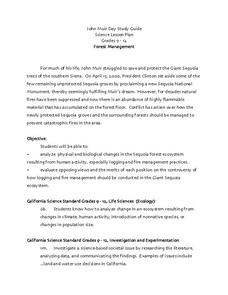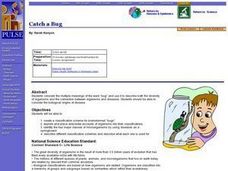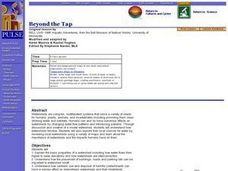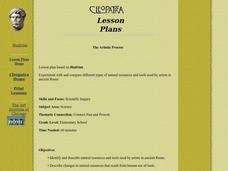Curated OER
Measurement of the Depth of the Ocean
Students comprehend the physical properties of pressure and Boyle's Law by designing a depth gauge. They construct a capillary depth gauge and calculate the calibrated depth marks of the capillary tube. They determine the margin of error...
Curated OER
Attenuation of Light in Water
Students explore what happens to light intensity as depth increases using a light intensity logger. They construct a PVC model to hold water and identify what factors could influence the amount of light attenuation.
Curated OER
What Does It Eat?
Students, working in research teams, investigate the eating habits of crickets. They collect and record data and compare their methods and results with other groups by making tables or graphs. They sumarize their findings with posters or...
Curated OER
Yeast Cells and Their Environment
Learners create their own experiment in which they have yeast cells growing in liquid environments. They examine the relationship between humans and microorganisms. They also practice using the scientific method.
Curated OER
Let Me Tell You About My State
Students develop an awareness of the concepts of the United States through the Amateur Radio communication services by verbally sharing information about their state such as cultures, current events, geography, history and much more.
Curated OER
Forest Management
Students explore the changes in the Sequoia forest ecosystem. They evaluate reasons for the changes and discuss opposing views of human activity, logging and fire management practices. Students observe a video, describe the location of...
Curated OER
Creating the "Perfect" Horse
Students examine horse biology and breeds while investigate the relationship between horses and riders. They research and analyze information found online in order to determine how to produce an all-purpose horse. They write position...
Curated OER
Why Invent That?
Students demonstrate an understanding of the text by completing an activity on the advantages and disadvantages of inventing and using a human-powered airplane.
Curated OER
DNA-a Molecular Identity
Young scholars explore about what DNA is and several different DNA typing techniques. They examine three different situations where DNA typing was used to carry out justice. Students also identify and evaluate different uses of DNA...
Curated OER
Household Pests
Sixth graders discover the various habitat requirements for assorted household pests from ants to wasps. They conduct various activities including researching the life cycles moths, cockroaches, and mosquitoes
Curated OER
Introduction To Pests
Students investigate common pests and match pests to their respective pictures. In a group discussion, students explore the basic needs of pests and share personal pest stories. They examine common self-protection measures. Using the...
Curated OER
Reopen: A Study of Five Closed Mines
Students analyze data to determine which of the fived closed mines would be beneficial to have reopen. They acquire knowledge of rocks and minerals in the area to give reasons why that mine should open again. Students gain knowledge in...
Curated OER
Destination Mars!
Fifth graders view Mysteries of Earth & Mars Video on DVD and record thoughts in their online journal. They record data in a spreadsheet about each planet then form a theory of the best time to launch a space craft from Earth to land...
Curated OER
Introduction to Pests
Students study common pests. They examine pest damage and self-protection against pests by reading a story, creating a class book and playing a game.
Curated OER
Arsenic and Human Health
Ninth graders concentrate on arsenic poisoning as an example of the connections among health, geography, and geology as they develop a persuasive presentation about the dangers of arsenic in the drinking water, targeting a specific...
Curated OER
Beyond the Tap
Students explain the basic properties of a watershed including how water flows from higher to lower elevations and how watersheds are interconnected. They comprehend how the placement of buildings, roads, and parking lots can be...
Curated OER
Superbugs and Antibiotic Resistance
High schoolers complete experiments on antibiotics and antimicrobials. In groups, they explain how antibiotics affect the evolution of microorganisms. They test various types of bacteria to discover how much resistance they have to...
Curated OER
Gas Properities Definitions
Young scholars, after reading the Web page Gas Properties Definitions, complete the activity to demonstrate an understanding of the properties of gases.
Curated OER
Just How Small is a Nanoparticle?
Students determine the size of a nanoparticle. In small groups, they calculate the actual size of a particle shown in a photo, and discuss how they arrived at their answers.
Curated OER
Seed Selection for Genetic Variation
Students will research the origin of corn, analyze factors that contribute to shorter and longer growing seasons, and use the scientific method to answer the question: Did seed selection contribute to the successful movement of corn from...
Curated OER
The Artistic Process
Students experiment with and compare different types of natural resources and tools used by artists in ancient Rome. They describe changes in natural resources that result from human use of tools.
Curated OER
Eat Your Sprouts Part I
Students will conduct a lab on the oxidation of an apple. The students will learn that the oxidation process can be halted when lemon juice is applied to the flesh of an apple because the lemon juice contains vitamin C, an antioxidant....
Curated OER
Mathematical Proofs
Students explore the nature of mathematical proofs and mathematical inquiry. They complete the activity "Using the Pythagorean Theorem". They read selected articles and participate in class discussions.
Curated OER
A Thoreau Look at Our Environment
Sixth graders write journal entries o school site at least once during each season, including sketched and written observations of present environment. They can use sample topographical maps and student's own maps. Students can use...

























